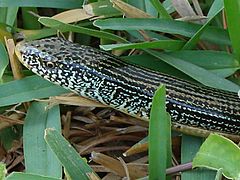Glass lizard facts for kids
Quick facts for kids Glass lizard |
|
|---|---|
 |
|
| Eastern glass lizard (Ophisaurus ventralis) | |
| Scientific classification | |
| Kingdom: | |
| Class: | |
| Order: | |
| Suborder: | |
| Family: | |
| Subfamily: |
Anguinae
|
| Genus: |
Ophisaurus
|
Glass lizards, sometimes called glass snakes, are a type of reptile that might trick you! Even though they look a lot like snakes, they are actually lizards. They belong to a group of animals called a genus (JEN-us). A genus is a scientific way to group very similar living things together.
Contents
What Makes a Glass Lizard?
Most glass lizards don't have legs. This is why many people confuse them with snakes. But if you look closely, you can spot some big differences! Glass lizards have eyelids that can move, just like yours. Snakes don't have eyelids and can't blink. Glass lizards also have ear openings on the outside of their heads. Snakes do not have these ear openings. Their head shapes are also different from snakes.
Tiny Legs?
A few types of glass lizards have very small, stub-like legs. These tiny legs are found near their rear vent, which is a body opening called a cloaca (kloh-AY-kuh). These small legs are known as vestigial organs (ves-TIJ-ee-ul OR-gans). This means they are body parts that have become small and mostly useless over a long time. They are leftovers from ancestors that had bigger, working legs.
Where Do They Live?
Glass lizards can be found in different parts of the world. Most of the known types live in Asia. A few kinds can be found in North America. At least one type of glass lizard lives in North Africa. They often live in grassy areas, woodlands, or sandy places.
Amazing Tail Trick!
Like many other lizards, glass lizards have a special defense mechanism. When they are attacked or feel threatened, they can drop off part of their tail. This amazing ability is called autotomy (aw-TOT-uh-mee). The tail can even break into several pieces, which is how they got the name "glass lizard." The tail keeps wiggling and moving after it breaks off. This helps to distract the predator, making it focus on the moving tail instead of the lizard. While the predator is busy with the tail, the lizard can stay still and then quickly escape to safety. Over time, the lizard will grow a new tail, though it might look a bit different from the original.
Images for kids
-
Slender glass lizard (Ophisaurus attenuatus)


